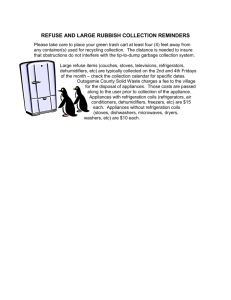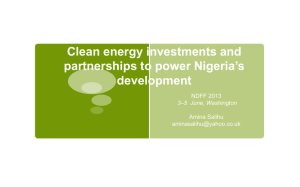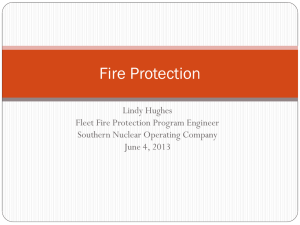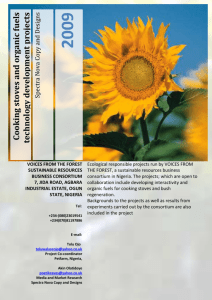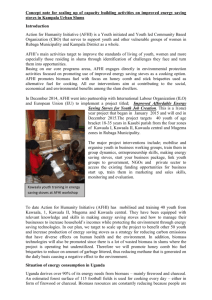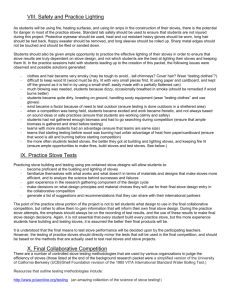Brief News letter11-10-08 - Iowa Natural Gas Association
advertisement
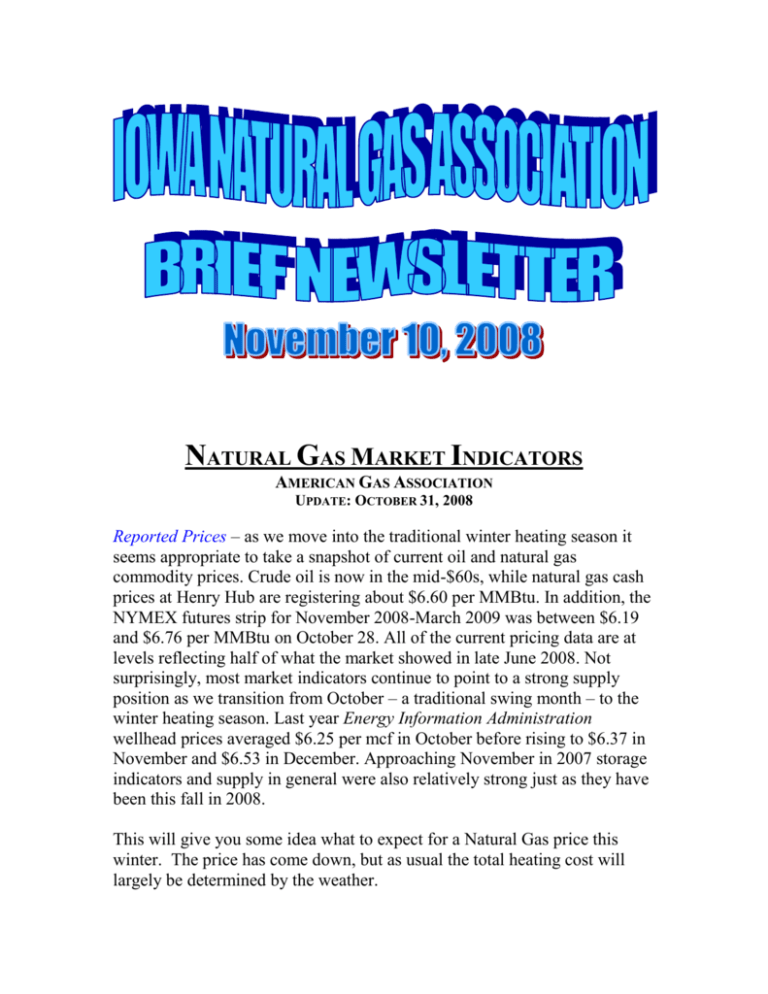
NATURAL GAS MARKET INDICATORS AMERICAN GAS ASSOCIATION UPDATE: OCTOBER 31, 2008 Reported Prices – as we move into the traditional winter heating season it seems appropriate to take a snapshot of current oil and natural gas commodity prices. Crude oil is now in the mid-$60s, while natural gas cash prices at Henry Hub are registering about $6.60 per MMBtu. In addition, the NYMEX futures strip for November 2008-March 2009 was between $6.19 and $6.76 per MMBtu on October 28. All of the current pricing data are at levels reflecting half of what the market showed in late June 2008. Not surprisingly, most market indicators continue to point to a strong supply position as we transition from October – a traditional swing month – to the winter heating season. Last year Energy Information Administration wellhead prices averaged $6.25 per mcf in October before rising to $6.37 in November and $6.53 in December. Approaching November in 2007 storage indicators and supply in general were also relatively strong just as they have been this fall in 2008. This will give you some idea what to expect for a Natural Gas price this winter. The price has come down, but as usual the total heating cost will largely be determined by the weather. NFPA 54: National Fuel Gas Code, 2009 Edition The manuals are available from the National Fire Protection Association at the following web site. The price is also shown below which does not include the shipping costs. http://www.nfpa.org/catalog/product.asp?pid=5409&src=nfpa&order_src=A292 Format List Member * Book $44.00 $39.60 PDF $44.00 $39.60 More information about NFPA 54 Fully revised, the 2009 NFPA 54: National Fuel Gas Code facilitates safer installations and better protection against fire and explosion hazards. Up-to-date with current techniques, products, materials, and construction practices, the 2009 National Fuel Gas Code provides a more effective means of ensuring fuel gas safety on consumers' premises. Based on scores of proposals from Code users like you, it presents designers, installers, AHJs, maintainers, and inspectors with state-of-the-art criteria for the installation and operation of gas piping systems, appliances, equipment, and related accessories. Changes in the 2009 edition that improve fuel gas safety include: New bonding requirement for corrugated stainless steel tubing (CSST) installed inside buildings protects against threats likely to energize gas piping. Addition of a new system of connecting copper tubing using a crimping tool for press-connect fittings New rule for a dedicated master shutoff valve for laboratories Revised requirements for radiant tube heaters prevent cracks, leaks, or fractures. New section adds minimum code coverage for permanently fixed outdoor open flame decorative appliances. Additional requirements for commercial cooking appliance connectors will reduce the risk of fugitive gas, potential fires, and subsequent losses. Termination of vents in a side wall revised to ensure reliability and prevent nuisance shutoffs. New language for vent termination in screened porches reduce possible dangers from harmful combustion products and potential fire hazards. Annexes provide valuable advice on sizing and capacities of gas piping, and sizing of venting systems serving appliances...checking for leakage…and emergency procedures for gas leaks. More than 100 graphics visually clarify concepts so you can avoid mistakes. Take fuel gas hazards seriously and mitigate risks. Stay up-to-code with the 2009 NFPA 54! (Softbound, 164 pp., 2009) COPIES OF THE NFPA 54 2006 EDITION ARE STILL AVAILABLE FROM THE IOWA NATURAL GAS ASSOCIATION OFFICE FOR THE PRICE OF $5.00 (which is the cost of shipping). AS LONG AS SUPPLIES LAST. It is better to have an old edition then not to have one at all. Please phone, write, or email the office if you are interested. The following information was received from AGA about emissions from gas stoves. AGA’s response to this information follows the article. Gas Stove Emissions Boost Asthma in Inner-City Kids Washingtonpost.com Friday, October 24, 2008 FRIDAY, Oct. 24 (HealthDay News) -- High levels of nitrogen dioxide emissions from gas stoves can aggravate asthma symptoms in inner-city children, especially pre-schoolers, a new study says. Nitrogen dioxide (NO2) is an irritating and toxic form of nitrogen oxide gas that is often present in industrial zones but can also be found at higher levels in poor homes with unvented gas stoves. Researchers from John Hopkins University, reporting in the October issue of Environmental Health Perspectives, tied asthma flare-ups in young children directly to high concentrations of NO2 in their Baltimore homes, most of which had gas stoves and/or natural gas heat. The stoves or ovens were often used for heating as well as cooking. Because using stoves as heat sources is a hallmark of urban poverty, our study tellingly points to how profound and direct the effects of purely social and environmental factors can be on a child's health," lead researcher Dr. Nadia Hansel, a Johns Hopkins lung expert, said in a news release issued by the university. "Doctors caring for children with asthma should always inquire about the home's heating and cooking appliances and urge those using gas-based stoves and space heaters to switch to electric heating and cooking, if possible, or at least properly vent the exhaust gases." Each 20 point increase in nitrogen dioxide levels led to 10 percent more days of cough and 15 percent more days with limited speech due to wheezing, the researchers said. Asthma affects 6.2 million children in the United States and is most prevalent in inner-city children. Doctors believe poor access to regular health care and added exposure to indoor allergens such as mouse and cockroach dander, dust, cigarette smoke and automobile fumes make the condition worse for these children. LETTER FROM AMERICAN GAS ASSOCIATION IN REPSONSE TO THE ABOVE ARTICLE October 30, 2008 Letters to the Editor, The Washington Post, Via email Dear Editor: The Johns Hopkins University study you recently reprinted (Gas Stove Emissions Boost Asthma in Inner-City Kids, Oct. 24) wrongly leads readers to believe that the proper use of gas stoves increases asthma symptoms in urban children. There is no evidence to suggest that the correct and safe use of gas stoves and ovens, i.e. for cooking purposes only, emits a problematic level of nitrogen dioxide. According to the National Academy of Sciences Institute of Medicine text, “Clearing the Air: Asthma and Indoor Air Exposures,” nitrogen dioxide and nitrogen oxide are agents for which there is “inadequate or insufficient evidence to determine whether or not an association exists,” for development of asthma. Problems arise, however, when people use their gas or electric stoves and ovens for home heating, which is a dangerous and unsafe practice that can result in fires. We agree with the authors of the Hopkins study that this is not an appropriate use of these appliances. The Consumer Product Safety Commission (CPSC) range and oven manufacturers issue strong warnings to consumers never to use this appliance for space heating. The recommended removal of gas cooking appliances is misguided advice to consumers. The American Gas Association encourages customers to use all of their appliances properly and to be informed about the hazards of their incorrect use. The 171 million natural gas customers in the United States can and should continue to use natural gas safely in their homes and businesses. Sincerely, David. N. Parker
